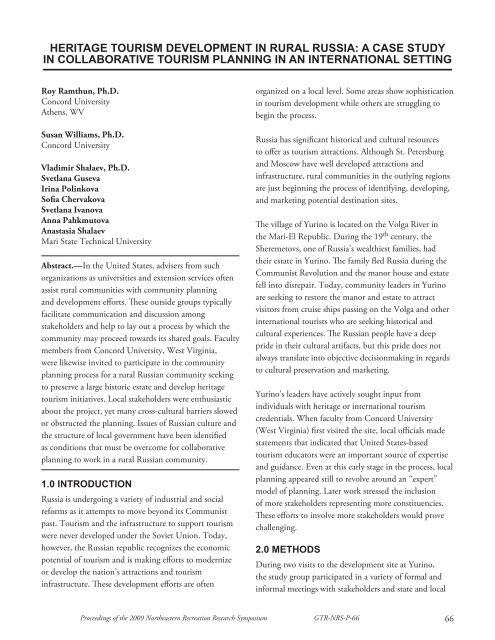Proceedings of the 2009 northeastern recreation research symposium
Proceedings of the 2009 northeastern recreation research symposium
Proceedings of the 2009 northeastern recreation research symposium
You also want an ePaper? Increase the reach of your titles
YUMPU automatically turns print PDFs into web optimized ePapers that Google loves.
HERITAGE TOURISM DEVELOPMENT IN RURAL RUSSIA: A CASE STUDY<br />
IN COLLABORATIVE TOURISM PLANNING IN AN INTERNATIONAL SETTING<br />
Roy Ramthun, Ph.D.<br />
Concord University<br />
A<strong>the</strong>ns, WV<br />
Susan Williams, Ph.D.<br />
Concord University<br />
Vladimir Shalaev, Ph.D.<br />
Svetlana Guseva<br />
Irina Polinkova<br />
S<strong>of</strong>i a Chervakova<br />
Svetlana Ivanova<br />
Anna Pahkmutova<br />
Anastasia Shalaev<br />
Mari State Technical University<br />
Abstract.—In <strong>the</strong> United States, advisers from such<br />
organizations as universities and extension services <strong>of</strong>ten<br />
assist rural communities with community planning<br />
and development eff orts. Th ese outside groups typically<br />
facilitate communication and discussion among<br />
stakeholders and help to lay out a process by which <strong>the</strong><br />
community may proceed towards its shared goals. Faculty<br />
members from Concord University, West Virginia,<br />
were likewise invited to participate in <strong>the</strong> community<br />
planning process for a rural Russian community seeking<br />
to preserve a large historic estate and develop heritage<br />
tourism initiatives. Local stakeholders were enthusiastic<br />
about <strong>the</strong> project, yet many cross-cultural barriers slowed<br />
or obstructed <strong>the</strong> planning. Issues <strong>of</strong> Russian culture and<br />
<strong>the</strong> structure <strong>of</strong> local government have been identifi ed<br />
as conditions that must be overcome for collaborative<br />
planning to work in a rural Russian community.<br />
1.0 INTRODUCTION<br />
Russia is undergoing a variety <strong>of</strong> industrial and social<br />
reforms as it attempts to move beyond its Communist<br />
past. Tourism and <strong>the</strong> infrastructure to support tourism<br />
were never developed under <strong>the</strong> Soviet Union. Today,<br />
however, <strong>the</strong> Russian republic recognizes <strong>the</strong> economic<br />
potential <strong>of</strong> tourism and is making eff orts to modernize<br />
or develop <strong>the</strong> nation’s attractions and tourism<br />
infrastructure. Th ese development eff orts are <strong>of</strong>ten<br />
organized on a local level. Some areas show sophistication<br />
in tourism development while o<strong>the</strong>rs are struggling to<br />
begin <strong>the</strong> process.<br />
Russia has signifi cant historical and cultural resources<br />
to <strong>of</strong>f er as tourism attractions. Although St. Petersburg<br />
and Moscow have well developed attractions and<br />
infrastructure, rural communities in <strong>the</strong> outlying regions<br />
are just beginning <strong>the</strong> process <strong>of</strong> identifying, developing,<br />
and marketing potential destination sites.<br />
Th e village <strong>of</strong> Yurino is located on <strong>the</strong> Volga River in<br />
<strong>the</strong> Mari-El Republic. During <strong>the</strong> 19 th century, <strong>the</strong><br />
Sheremetovs, one <strong>of</strong> Russia’s wealthiest families, had<br />
<strong>the</strong>ir estate in Yurino. Th e family fl ed Russia during <strong>the</strong><br />
Communist Revolution and <strong>the</strong> manor house and estate<br />
fell into disrepair. Today, community leaders in Yurino<br />
are seeking to restore <strong>the</strong> manor and estate to attract<br />
visitors from cruise ships passing on <strong>the</strong> Volga and o<strong>the</strong>r<br />
international tourists who are seeking historical and<br />
cultural experiences. Th e Russian people have a deep<br />
pride in <strong>the</strong>ir cultural artifacts, but this pride does not<br />
always translate into objective decisionmaking in regards<br />
to cultural preservation and marketing.<br />
Yurino’s leaders have actively sought input from<br />
individuals with heritage or international tourism<br />
credentials. When faculty from Concord University<br />
(West Virginia) fi rst visited <strong>the</strong> site, local <strong>of</strong>fi cials made<br />
statements that indicated that United States-based<br />
tourism educators were an important source <strong>of</strong> expertise<br />
and guidance. Even at this early stage in <strong>the</strong> process, local<br />
planning appeared still to revolve around an “expert”<br />
model <strong>of</strong> planning. Later work stressed <strong>the</strong> inclusion<br />
<strong>of</strong> more stakeholders representing more constituencies.<br />
Th ese eff orts to involve more stakeholders would prove<br />
challenging.<br />
2.0 METHODS<br />
During two visits to <strong>the</strong> development site at Yurino,<br />
<strong>the</strong> study group participated in a variety <strong>of</strong> formal and<br />
informal meetings with stakeholders and state and local<br />
<strong>Proceedings</strong> <strong>of</strong> <strong>the</strong> <strong>2009</strong> Nor<strong>the</strong>astern Recreation Research Symposium GTR-NRS-P-66<br />
66
















